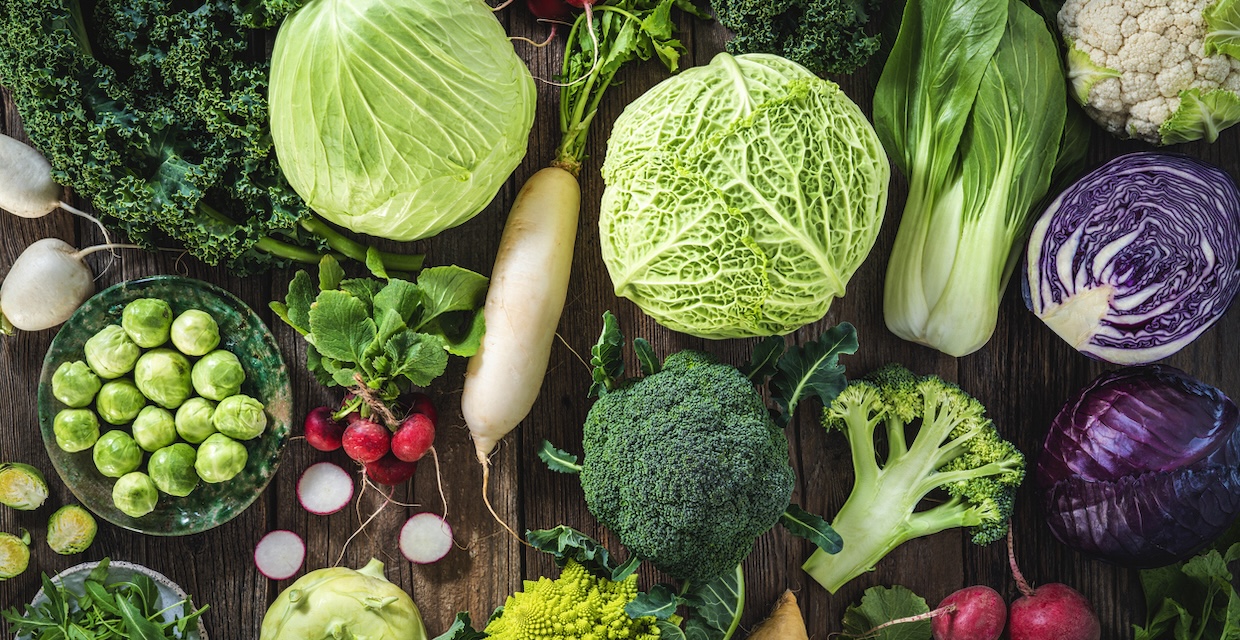Key Points
- A low-sulfur diet temporarily limits foods high in sulfur compounds to reduce symptoms like gas, bloating, and diarrhea, particularly for those with certain gut conditions.
- The diet focuses on reducing the fuel for specific gut bacteria that produce excess hydrogen sulfide (H2S) gas, which can irritate the gut lining.
- High-sulfur foods include cruciferous vegetables (broccoli, cauliflower), alliums (onions, garlic), red meat, eggs, dairy, and wine.
- This is not a long-term diet. It's an elimination-style plan best done under the guidance of a healthcare provider or registered dietitian to identify trigger foods and prevent nutrient deficiencies.
Is your gut health causing you frustration? If you’re dealing with constant bloating, gas, or digestive upset, you’ve likely tried a dozen different things to find relief. Sometimes, the issue isn't just what you’re eating, but how your body – and the trillions of bacteria in your gut – are processing it.
Enter: the low-sulfur diet.
You might have heard about it in online forums or from a friend, and you’re probably wondering if it’s the key to feeling better. This diet is gaining attention for its potential to help manage symptoms in conditions like irritable bowel syndrome (IBS) and small intestinal bacterial overgrowth (SIBO).
But what does eating a low-sulfur diet actually involve, and how does it work? Let's break it down so you can figure out if it's the right approach for you.
What exactly is a low-sulfur diet?
A low-sulfur diet is a temporary eating plan designed to reduce the intake of foods containing sulfur. Sulfur is an essential mineral your body needs for many critical functions, including building and repairing DNA, protecting your cells from damage, and making proteins. So, why would anyone want to limit it?
The diet doesn't aim to eliminate sulfur entirely – that would be unhealthy. Instead, it focuses on reducing specific sulfur-containing compounds that can cause problems for some people.
Think of it less like a permanent lifestyle and more like a short-term investigation. The main goal is to calm down your digestive system by starving out certain gut bacteria that might be causing trouble. By temporarily removing their favorite foods, you can see if your symptoms improve and pinpoint which foods are your personal triggers.
Why would someone try a low-sulfur diet?
The main reason people turn to a low-sulfur diet is to manage digestive issues.
“In conditions like small intestinal bacterial overgrowth (SIBO) or inflammatory bowel disease (IBD), excess sulfur can trigger bloating, cramps, and diarrhea,” says Nicholas Rush, RD. “Lowering sulfur intake may help reduce symptoms and support gut healing.”
Here’s the simple science behind it: your gut is home to trillions of microbes, including a specific group called sulfate-reducing bacteria (SRBs). These bacteria eat the sulfur compounds from your food and, as a byproduct, produce hydrogen sulfide (H2S) gas.
In a healthy gut, a small amount of H2S gas is normal and can even be beneficial. However, if you have an overgrowth of these SRBs, or if your gut is particularly sensitive, they can produce too much H2S gas. Research suggests that this excess gas can lead to symptoms like:
- Excessive, foul-smelling gas (like rotten eggs)
- Bloating and abdominal pain
- Diarrhea
- General gut inflammation
New research found that a low-sulfur diet significantly reduced hydrogen sulfide gas production and improved gut symptoms in participants. By cutting back on high-sulfur foods, you essentially cut off the fuel supply for these gas-producing bacteria, giving your gut a chance to rest and your symptoms a chance to subside.
A closer look at your gut microbiome & sulfur
The connection between diet and gut health is all about the microbiome. When you eat, you're not just feeding yourself; you're feeding the vast community of bacteria living in your intestines.
The balance of these bacteria is delicate. Some bacteria are helpful, while others can cause problems if they grow too numerous. Sulfate-reducing bacteria are a perfect example. A growing body of evidence links an overabundance of these bacteria and high levels of H2S gas to flare-ups in IBD (like Crohn's and ulcerative colitis) and worsening symptoms in IBS.
It’s important to remember that sulfur-containing foods, especially vegetables like broccoli and garlic, also contain prebiotics that feed your good gut bacteria. This is why a low-sulfur diet is a balancing act. The goal isn't to demonize these healthy foods, but to temporarily reduce them to rebalance your gut environment. It's a short-term strategy, not a forever plan.
High-sulfur foods to limit
When starting a low-sulfur diet, you will temporarily avoid or reduce foods rich in sulfur compounds. This list can seem long and a bit surprising, as it includes many otherwise healthy foods.
Here are the main categories of high-sulfur foods to limit:
- Cruciferous vegetables: This is a big one. It includes broccoli, cauliflower, Brussels sprouts, kale, cabbage, bok choy, and arugula.
- Allium vegetables: These are the flavorful staples in many kitchens: onions, garlic, leeks, shallots, and chives.
- Red and processed meats: Beef, pork, and lamb are higher in sulfur amino acids than poultry and fish. That said, meat in general is high in sulfur and needs to be monitored. Cured meats like bacon and sausage often contain added sulfites. One study found that high intake of sulfur from these sources was associated with an increased risk of distal colon cancer.
- Eggs: The yolk is particularly high in sulfur.
- Dairy Products: Milk, cheese, yogurt, and sour cream contain sulfur. Cheddar cheese is especially high.
- Legumes: While a great source of fiber, many beans and lentils (like chickpeas and black beans) are high in sulfur.
- Nuts and Seeds: Sunflower seeds and almonds are among the higher-sulfur options.
- Certain Fruits and Juices: Dried fruits preserved with sulfur dioxide are a major source. Grape juice and tomato juice also contain sulfur.
- Beverages: Wine and cider are often high in sulfites, which are used as preservatives.
- Condiments: Mustard and horseradish get their signature kick from sulfur compounds.
Low-sulfur foods to enjoy
While the "avoid" list might seem daunting, there are still plenty of delicious and nutritious foods you can eat. Focusing on what you can have makes the diet much more manageable.
“Opt for lower-sulfur proteins like poultry, fish, tofu, and legumes, and enjoy fruits, grains, and veggies like berries, quinoa, and zucchini,” says Nicholas Rush, RD. “Gentle cooking methods like steaming or boiling chicken, fish, and low-sulfur vegetables, as well as quick-chilling hard-boiled eggs, can help reduce sulfur without sacrificing flavor.”
Here’s a list of low-sulfur foods to build your meals around:
- Vegetables: Bell peppers, cucumber, zucchini, eggplant, carrots, celery, lettuce, potatoes, sweet potatoes, and green beans.
- Fruits: Bananas, melons, pears, peaches, avocados, and blueberries are generally good choices.
- Proteins: Poultry (chicken, turkey) and fish are excellent low-sulfur options.
- Grains: Rice, oats, and quinoa are typically well-tolerated.
- Healthy fats: Olive oil, avocado oil, and coconut oil are great for cooking.
- Beverages: Water is your best friend. Herbal teas (without high-sulfur ingredients) are also fine.
- Herbs and spices: You can still add plenty of flavor with basil, oregano, parsley, rosemary, and thyme.
A sample 5-day low-sulfur meal plan
Wondering what a day on this diet looks like? It can be hard to imagine at first, especially when you have to set aside some of your go-to ingredients. Here’s a look at what five days on a low-sulfur diet could look like, focusing on variety and flavor to keep things interesting.
Day 1
- Breakfast: A bowl of oatmeal made with water or a low-sulfur milk alternative (like almond milk), topped with sliced bananas and a sprinkle of cinnamon.
- Lunch: A large salad with mixed greens, grilled chicken strips, cucumber, bell peppers, and carrots, dressed with a simple olive oil and lemon juice vinaigrette.
- Snack: Sliced pear with a small handful of macadamia nuts.
- Dinner: Baked salmon seasoned with dill and lemon, served with roasted sweet potato wedges and steamed green beans.
Day 2
- Breakfast: A smoothie made with a ripe banana, a handful of blueberries, and a spoonful of avocado for creaminess, blended with water or a safe milk alternative.
- Lunch: Leftover baked salmon and roasted sweet potatoes from the previous night's dinner.
- Snack: Cucumber slices with a sprinkle of sea salt.
- Dinner: A simple chicken stir-fry using sliced chicken breast, bell peppers, carrots, and zucchini, cooked in a little sesame oil. Serve over a bed of fluffy white rice.
Day 3
- Breakfast: Cooked quinoa porridge. Prepare quinoa with water, and top it with fresh peach slices and a drizzle of maple syrup.
- Lunch: Turkey lettuce wraps. Sauté ground turkey with finely chopped celery and carrots, seasoned with low-sulfur herbs like oregano and basil. Spoon the mixture into large butter lettuce leaves.
- Snack: A ripe pear.
- Dinner: Baked cod seasoned with parsley and olive oil. Serve with a side of roasted carrot sticks and steamed green beans.
Day 4
- Breakfast: Sweet potato "toast." Slice a sweet potato into ¼-inch thick slabs and toast them until tender. Top with mashed avocado and a sprinkle of sea salt and pepper.
- Lunch: Leftover baked cod and roasted veggies from the previous night.
- Snack: A handful of fresh blueberries.
- Dinner: Turkey meatballs (made with ground turkey and crushed oats or rice crumbs as a binder) served over zucchini noodles with a fresh basil pesto (made without cheese or garlic).
Day 5
- Breakfast: A bowl of oatmeal (as on Day 1), this time topped with fresh peach slices and a few chopped macadamia nuts.
- Lunch: Leftover turkey meatballs and zucchini noodles.
- Snack: Celery sticks.
- Dinner: A low-sulfur "Buddha bowl." Start with a base of quinoa and top with sliced grilled chicken, steamed green beans, shredded carrots, and diced cucumber. Drizzle with a dressing of olive oil, lemon juice, and thyme.
This plan shows that a temporary low-sulfur diet can still be flavorful and satisfying. Remember to drink plenty of water throughout the day.
Is a low-sulfur diet a long-term solution?
It's crucial to understand that the low-sulfur diet is an elimination diet, not a forever diet. Long-term restriction of sulfur-rich foods can lead to nutrient deficiencies. Many high-sulfur foods, like cruciferous vegetables, are packed with vitamins, minerals, and powerful antioxidants your body needs for long-term health. For example, compounds in broccoli are well-studied for their role in cancer prevention.
The typical process involves three phases:
- Elimination phase (2-4 weeks): You strictly avoid high-sulfur foods to see if your symptoms improve.
- Reintroduction phase: Under the guidance of a dietitian, you systematically reintroduce one high-sulfur food group at a time, monitoring for any returning symptoms. This helps you identify your specific trigger foods and your personal tolerance level.
- Personalized maintenance phase: You return to eating a varied diet, limiting only the foods that you've confirmed cause you problems.
This structured approach ensures you get the benefits of symptom relief without sacrificing the long-term benefits of a diverse diet. A registered dietitian can be an invaluable partner in this process, helping you navigate the complexities and create a sustainable plan.
Final Thoughts
A low-sulfur diet can be a powerful tool for anyone struggling with unexplained digestive issues, especially those related to gas and bloating from IBS or SIBO. By temporarily reducing the fuel for gas-producing gut bacteria, you can often find significant symptom relief and begin the process of identifying your personal trigger foods.
However, this isn't a diet to start lightly or to stay on indefinitely. The reintroduction phase is just as important as the elimination phase. Working with a healthcare professional ensures you do it safely, effectively, and without missing out on essential nutrients in the long run.
If you think a low-sulfur diet might be right for you, consider it a short-term experiment to gather information about your body. With the right guidance, it could be the first step toward a happier, calmer gut.
Frequently Asked Questions
How long does it take for a low-sulfur diet to work?
Many people start to notice an improvement in their symptoms, such as reduced bloating and gas, within the first one to two weeks of the elimination phase. However, it's generally recommended to follow the strict elimination for 2-4 weeks to get a clear picture of its effects.
Does coffee have a lot of sulfur?
Coffee does contain sulfur compounds, which contribute to its aroma and flavor. However, it's not typically considered one of the highest-sulfur foods to avoid. For many people, a cup of black coffee is well-tolerated, but if you're very sensitive, you might need to test your personal tolerance during the reintroduction phase.
What are the symptoms of too much sulfur in the body?
For most people, dietary sulfur isn't a problem. However, in individuals with sensitive guts or an overgrowth of sulfate-reducing bacteria, "too much" sulfur can manifest as digestive symptoms like foul-smelling gas, bloating, abdominal pain, and diarrhea.
Is a low-sulfur diet the same as a low FODMAP diet?
No, they are different, though they have some overlap. The low FODMAP diet restricts a broad category of fermentable carbohydrates that can cause gas and bloating. The low-sulfur diet specifically targets sulfur-containing foods. Some foods, like garlic and onions, are high in both, but many are not. For example, broccoli is high in sulfur but low in FODMAPs. A dietitian can help you determine which diet is more appropriate for your specific symptoms.
The views expressed by authors and contributors of such content are not endorsed or approved by Fay and are intended for informational purposes only. The content is reviewed by Fay only to confirm educational value and audience interest. You are encouraged to discuss any questions that you may have about your health with a healthcare provider.
Sources
Fay Nutrition has strict sourcing guidelines and relies on peer-reviewed studies, academic research institutions, and medical associations. We avoid using tertiary references.
- Small Intestinal Bacterial Overgrowth - StatPearls
- Role of Hydrogen Sulfide in Inflammatory Bowel Disease - MDPI Antioxidants
- Association Between the Sulfur Microbial Diet and Risk of Colorectal Cancer - JAMA
- Broccoli and Cruciferous Vegetables: Reduce Overall Cancer Risk - American Institute for Cancer Research
- Impact of diet on hydrogen sulfide production: implications for gut health - Current Opinion in Clinical Nutrition and Metabolic Care











